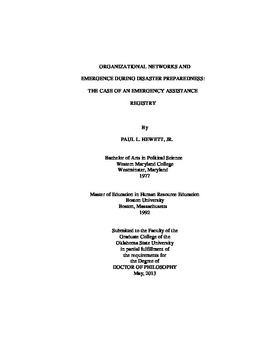| dc.description.abstract | Natural, technological, and human-caused disasters affect minorities and individuals with lower socioeconomic status more than people with non-minority, high socioeconomic status. Age, disability, and health can compound disaster impact. These factors could limit an individual's access to emergency services or contribute to a need for functional assistance during disaster. Emergency planners must consider how government and non-government organizations can provide the same disaster-related services as those provided to the general population that meet the requirements of people who have self-identified as having an access or functional need. Registries often are recommended as the most useful, primary means of locating such individuals prior to, during, or after disaster. However, scarce empirical or practice-based research supports this recommendation as practitioners and researchers have not evaluated and assessed the usefulness, effectiveness, or impact of emergency assistance registries. This study considered how communities support registry operations and their effectiveness, and it provided data to help establish a base for comparing registry operations in other locations. Through an embedded, single-case study, this dissertation explored Calhoun County, Alabama's experiences and perceptions with operating an emergency assistance registry. It used qualitative methods for data collection and analysis regarding the registry designed to support the Chemical Stockpile Emergency Preparedness Program (CSEPP). Data from individual interviews, registry records, registry-related reports, and clarifying conversations revealed how and why this emergency assistance registry operated in the context of local risk. The analysis indicated that publicly presented purposes for the registry had a more direct effect on registry design than did official purposes. Analysis also revealed evidence of emergent phenomena as the network of organizations' formation and interactions bridged gaps in service. Finally, the evidence suggested that post-CSEPP registry operations were moving from a loosely coupled, emergent model toward a command and control, dominant-theory model. Implications for future practice include the need for (1) further research into list-of-list and service provider registration, (2) recognizing the inherent contract caused by registry establishment, (3) emergency managers aligning provided services with the hazards and associated risk registrants face, and (4) tailoring providers' disaster-related service delivery to meet individual registrant needs. | |
